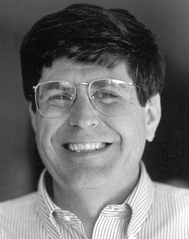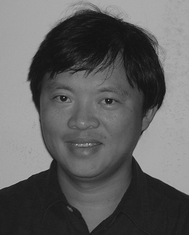SPECIAL ISSUE FOREWORD
Guest Editors
Professor Klavs Jensen & Professor Abraham Lee
The Science & Applications of Droplets in Microfluidic Devices

 The rapidly increasing interest in the formation and use of droplets in microfluidic channels motivates this special issue of Lab on a Chip. Droplets are formed by contacting two immiscible fluids in such a manner that one fluid becomes dispersed in the other continuous fluid phase as droplets and forms an emulsion. In macroscopic systems, emulsions are typically formed by rapid shearing in specialized mixers and they are stabilized by the presence of surfactants. The resulting emulsion typically has a wide distribution of particle sizes. Microfluidics provides the opportunity for generating stable microemulsions of uniform particle size1,2 with the potential for scale-up of droplet production by many devices operating in parallel. The size of droplets in microfluidic systems can be controlled by device geometry and hydrodynamic flow characteristics. Selection of flow conditions, geometry, and fluid properties enables generation of uniform droplet sizes as well as merging and splitting of droplets.2 The ability to incorporate electrodes and generate local electrical fields in microfluidic devices provides additional means for manipulating droplets. Microelectrode arrays with programmed electric fields create dielectrophoretic and electrowetting forces transporting droplets, merging droplets, and splitting droplets in microfluidic equivalents of microprocessors.
The rapidly increasing interest in the formation and use of droplets in microfluidic channels motivates this special issue of Lab on a Chip. Droplets are formed by contacting two immiscible fluids in such a manner that one fluid becomes dispersed in the other continuous fluid phase as droplets and forms an emulsion. In macroscopic systems, emulsions are typically formed by rapid shearing in specialized mixers and they are stabilized by the presence of surfactants. The resulting emulsion typically has a wide distribution of particle sizes. Microfluidics provides the opportunity for generating stable microemulsions of uniform particle size1,2 with the potential for scale-up of droplet production by many devices operating in parallel. The size of droplets in microfluidic systems can be controlled by device geometry and hydrodynamic flow characteristics. Selection of flow conditions, geometry, and fluid properties enables generation of uniform droplet sizes as well as merging and splitting of droplets.2 The ability to incorporate electrodes and generate local electrical fields in microfluidic devices provides additional means for manipulating droplets. Microelectrode arrays with programmed electric fields create dielectrophoretic and electrowetting forces transporting droplets, merging droplets, and splitting droplets in microfluidic equivalents of microprocessors.Taylor described the recirculation that occurs in a laminar flow of drops dispersed in a second, immiscible fluid phase following in a tube.3 In the equivalent microfluidic systems, this recirculation can be exploited in micromixers4 and discrete chemical reactors.5 The ability to control transport, merging, and splitting of drops affords the opportunity to realize programmable systems for studying and implementing reaction networks. These reaction networks could be steps in a chemical synthesis effort or part of a combinatorial study aimed at discovering new reaction platforms. Since each droplet functions as a batch reactor moving along a channel, the contact time corresponds to the length traveled by the droplet. Consequently, sampling of droplets at different spatial locations can be used to deduce chemical kinetics,6 provided that the local micromixing is faster than the chemical reaction rate. The control of local mixing, droplet movements, and droplet residence time distributions creates additional opportunities for applications in materials synthesis, in particular for continuous nanoparticle synthesis.
The eight papers collected in this special issue highlight the recent developments in multiphase droplet flows in microfluidic channels. They can be divided into four categories:
1. Microfluidic devices for passive and active droplet manipulations. Tan et al.7 describe bifurcation microchannel geometries for splitting, fusing, and sorting droplets. The microfluidic devices are driven by external “off-chip” syringe pumps. As a result, the manipulation of droplets is passive and relies purely on the local design features. It is possible to deal with large numbers of droplets to perform sorting, splitting, and fusing functions to control the size and contents in each droplet. The paper also demonstrates the ability to control and sort chemical concentrations with applications in combinatorial screening/synthesis. Gascoyne et al.8 describe active programmable fluidic processors based on dielectrophoresis (DEP) forces. These devices are microfluidic equivalents of microprocessors, creating a platform for general purpose droplet processing that is reconfigurable and programmable. The authors demonstrate an embodiment based on a scaleable CMOS architecture that uses DEP manipulation on a 32 × 32 electrode array having built-in control and switching circuitry.
2. Theory and simulation of droplets in microfluidic channels. Cristini and Tan9 review the theoretical foundation of droplet dynamics in fluids, including the breakup and coalescence transitions based on the complex interplay of viscous, inertial, capillary, Marangoni, electrostatic and Van der Waals forces over a wide variety of spatial and time scales. They further describe how numerical simulations can assist in the analysis of complex flow and geometries, while also describing limitations in the techniques and how they must be combined with asymptotic theories and experimental validations. Zeng and Korsmeyer10 delineate principles of electrohydrodynamics for droplets. The droplets are manipulated under two major operating principles, electrowetting on dielectric and DEP. This paper analyzes these two major operation principles under a unified framework of “droplet electrohydrodynamics”. Simulations are used extensively in the paper to illustrate microfluidic device operation and to expose the underlying physics.
3. Detection and characterization of droplets. Omrane et al.11 describe laser techniques applied to an acoustically levitated droplet for remote investigation of the diameter, the species concentration and the temperature of the droplets. The droplets were seeded with thermographic phosphors and acetone for the phosphorescence and fluorescence measurements, respectively. Temperature measurements in droplets enable the study of exothermic chemical and biochemical reactions that are temperature sensitive and dependent. Günther et al.12 describe micro particle image velocimetry (μPIV) and fluorescence microscopy techniques to characterize microscale segmented gas-liquid flow at low superficial velocities relevant for chemical reactions. The recirculation motion in liquid-segments is quantified along with residence time distributions of fluid elements in multiphase microfluidic systems. Synthesis of colloidal silica exemplifies the use of controlled multiphase residence time distributions in microfluidic systems
4. Applications – chemical reactions and physiological diagnostics. Srinivasan et al.13 describe an integrated microfluidic lab-on-a-chip utilizing the electrowetting effect to perform bioassays on real physiological samples (serum, tear, plasma, urine, and saliva). They performed colorimetric enzymatic glucose assays that hold promise for clinical diagnostics for human physiological fluids. The lab-on-a-chip described integrates sample injection, on-chip reservoirs, droplet formation structures, fluidic pathways, mixing areas and optical detection sites, on the same substrate. Shestopalov et al.14 from the University of Chicago describe a plug-based, microfluidic method for performing multi-step reactions with millisecond time-control. The further reactions were enabled by merging an aqueous stream with aqueous droplets. They demonstrated the utility of this microfluidic method for chemical reactions by synthesizing colloidal CdS and CdS/CdSe core-shell nanoparticles.
References
- T. Thorsen, R. W. Roberts, F. H. Arnold and S. R. Quake, Phys. Rev. Lett., 2001, 86, 4163–4166 CrossRef CAS.
- D. R. Link, S. L. Anna, D. A. Weitz, H. A. Stone, Phys. Rev. Lett., 2004, 92, Art. No. 054503 Search PubMed.
- G. I. Taylor, Proc. R. Soc. London A, 1953, 219, 186–203 Search PubMed.
- M. A. Burns, B. N. Johnson, S. N. Brahmasandra, K. Handique, J. R. Webster, M. Krishnan, T. S. Sammarco, P. M. Man, D. Jones, D. Heldsinger, C. H. Mastrangelo and D. T. Burke, Science, 1998, 282, 484–487 CrossRef CAS.
- J. D. Tice, H. Song, A. D. Lyon and R. F. Ismagilov, Langmuir, 2003, 19, 9127–9133 CrossRef CAS.
- H. Song, J. D. Tice and R. F. Ismagilov, Angew. Chem. Int. Ed. Engl., 2003, 42, 768–772 CrossRef CAS.
- Y.-C. Tan, J. S. Fisher, A. I. Lee, V. Cristini and A. P. Lee, Lab Chip, 2004, 4, 292 RSC.
- P. R. C. Gascoyne, J. V. Vykoukal, J. A. Schwartz, T. J. Anderson, D. M. Vykoukal, K. W. Current, C. McConaghy, F. F. Becker and C. Andrews, Lab Chip, 2004, 4, 299 RSC.
- V. Cristini and Y.-C. Tan, Lab Chip, 2004, 4, 257 RSC.
- J. Zeng and T. Korsmeyer, Lab Chip, 2004, 4, 265 RSC.
- A. Omrane, S. Santesson, M. Aldén and S. Nilsson, Lab Chip, 2004, 4, 287 RSC.
- A. Günther, S. A. Khan, M. Thalmann, F. Trachsel and K. F. Jensen, Lab Chip, 2004, 4, 278 RSC.
- V Srinivasan, V. K. Pamula and R. B. Fair, Lab Chip, 2004, 4, 310 RSC.
- I. Shestopalov, J. D. Tice and R. F. Ismagilov, Lab Chip, 2004, 4, 316 RSC.
| This journal is © The Royal Society of Chemistry 2004 |
